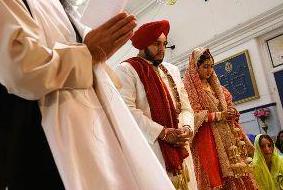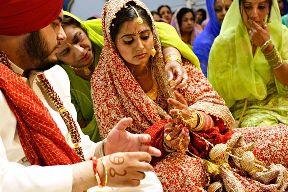|
Union cabinet passed much awaited Sikh Anand marriage Act
Los Angeles, April 12, 2012
Gary Singh
/
New Delhi-
Col. Atma Singh
The union cabinet today passed much awaited Anand marriage act which was big demand of the sikh community not only residing in India but abroad also.
Sikh Community in India and worldwide thanked Dr Manmohan Singh and the UPA chairperson Smt Sonia Gandhi for accepting the bill in the same form as it was presented before the parliamentary standing committee.
This has been a long standing demand of the Sikh community and NRIs thank the Union Cabinet and government for keeping its promise in acknowledging Sikh's separate identity.
The Britishers recognized Sikhs as a minority community and had passed the Anand Marriage Act 1909 legalising the Sikh rites of marriage. After independence, Sikhs were not given the minority status and have to register their marriages under Hindu Marriage Act.
The sikhs always feel that they need to have a separate marriage act for the Sikhs as Muslims, Christians, Parsis and Jews already have their own marriage acts
In 2007, Pakistan had enacted the Sikh Anand Marriage Act validating Sikh marriages.
From Toronto, Ramesh Gupta said: Now, Indian Govt is playing a positive role to bring peace, bring community together and investment in India. This would have been better if justice have been done whether it is 1984 roits or 2002 gujarat riot. It has always been the talking point on the damage it did to the secular fabric of India.
From Los Angeles, Ranbir Singh said: Captain Arminder Singh had separately met the Prime Minister and the Home and Law Ministers for the introduction of the Anand Marriage Act which was finally approved by the cabinet today
Former Union Minister, S. Dhindsa said, "A separate Marriage Act was the birth right of Sikhs, which had been denied to them since a century. This has been a long standing demand of the Sikh community and we thank the Union Cabinet and government for keeping its promise in acknowledging Sikh's separate identity"
-----
Anand Karaj is the Sikh marriage ceremony, meaning "Blissful Union" or "Joyful Union". It was introduced by Guru Amar Das.
- The four Lavan--marriage hymns which take place during the marriage ceremony, were composed by his successor, Guru Ram Das.
- It was originally legalised in India through the passage of the Anand Marriage Act 1909 but is now governed by the Sikh Reht Maryada (Sikh code of conduct and conventions) that was issued by the Shiromani Gurdwara Prabandhak Committee (SGPC). It dictates that only those who follow the Sikh religion may marry under the ceremony, therefore, Sikhs cannot marry persons professing other religions under it. It also states that child marriage is invalid and that no account should be taken of the prospective spouse's caste.
In a recent verdict of the Sri Akaal Takht Sahib,i.e. a Hukumnama, Anand Karaj can only take place in a Gurudwara. Any Amritdhari (Baptized) sikh may perform the marriage ceremony.
----
The Anand Marriage Act, 1909
THE AN AND MARRIAGE ACT, 1909
(7OF1909)
[22nd October, 1909]
An Act to remove doubts as to the validity of the marriage ceremony common
among the Sikhs called Anand.
whereas it is expedient to remove any doubts as to the validity of the marriage ceremony common among the Sikhs called Anand;
It is hereby enacted as follows:—
Statement of Objects and Reasons.—The object of the Bill is to set at rest doubts which may be raised of the validity of the marriage rite of the Sikhs called “Anand”.
This form of marriage has long been practised among the Sikhs but there are good reasons to believe that in the absence of validating enactment, doubts may be thrown upon it and Sikhs may have to face great difficulties in future and incur heavy expenses on suits instituted in the Civil Courts. It is also apprehended that in the absence of such law some Judicial Officers may be uncertain as to the validity of this orthodox Sikh custom.
It is desirable therefore, that all doubts should be set at rest for the future bypassing this enactment which merely validates and accepting the rite by following any new principles.
1. Short title and extent.—(1) This Act may be called the anand marriage Acr,1909.
(2) It extends to the whole of India J[except the State of Jarnmu and Kashmir].
2. Validity of Anand marriage.—All marriages which may be or may have been duly solemnised according to the Sikh Marriage ceremony called Anand shall be and shall be deemed to have been with effect from the date of the solemnization of each respectively, good and valid in law.
3. Exemption of certain marriages from Act.—Nothing in this Act shall apply to—
(a) any marriage between persons not professing the Sikh religion, or
(b) any marriage which has been judicially declared to be null and void.
4. Saving of marriages solemnized according to other ceremonies.—
Nothing in this Act shall affect the validity of any marriage duly solemnized according to any other marriage ceremony customary among the Sikhs.
5. Non-validation of marriages within prohibited degrees.—Nothing in this Act shall be deemed to validate any marriage between persons who are related to each other in any degree of consanguinity or affinity which would, according to the customary law of the Sikhs, render a marriage between them illegal.
1. Substituted by Act 48 of 1959, S. 3 and Sch.l, for certain words (w.e.f. 1-2-1960).
Anand Karaj: statutory recognition
during the British rule in India by the Anand Marriage Act
1909.
Authority for the following article is "The Code
of Sikh Conduct and Conventions" (Sikh Reht Mayada) issued
by the Shromani Gurdwara Parbandhak Committee, the supreme
council of the Sikhs based at Amritsar.
The Sikh marriage is called Anand Karaj. This form of marriage
was introduced from the time of the Sikh Gurus and was given
statutory recognition during the British rule in India by
the Anand Marriage Act 1909.
Sikh Code (Sikh Reht Maryada)Anand Karaj ceremony:
According to the centrally approved Sikh Code (Sikh Reht
Maryada), persons not professing the Sikh faith cannot be
joined in wedlock by the Anand Karaj ceremony.
Grown up Sikh boys and girls get married when they are fully
able to take on the responsibilities of married life. Child
marriage is forbidden. Sikh marriages may be arranged and
assisted by parents but this is not necessary. Boys and girls
may meet directly and get married. Religious guidance is that
a Sikh man and woman should enter wedlock without giving thought
to the prospective spouse's caste.
An engagement ceremony may take place before the wedding
but this is not necessary. Any day suitable to the parties
is fixed without regard to any superstition about auspicious,
good or bad days. Hindu type of marriage rituals are strictly
forbidden.
Most marriages take place in the morning. The ceremony starts
with a meeting of the two sides called "Milni" at
which holy shabads (hymns from the Sikh Scripture, Guru Granth
Sahib) are sung and often an Ardaas (supplication) is said
at the Milni (not prescribed).
The two sides say the Sikh greeting to each other with "Waheguru
Ji Ka Khalsa, Waheguru Ji Ki Fateh" (Khalsa belongs to
the Wondrous Giver of Knowledge; to whom also belongs victory.)
The marriage ceremony takes place at a congregational gathering
in the holy presence of Guru Granth Sahib. Shabads (Sikh hymns)
are sung and the boy and the girl sit side by side facing
Guru Granth Sahib. The girl sits on the left side of the boy.
The couple and their parents (or guardians) stand up and an
Ardaas seeking the Blessing of Waheguru (the Wondrous Giver
of Knowledge) for the commencement of the Anand marriage is
offered.
Any Amritdhari Sikh (man or woman who has undergone traditional
Amrit initiation and therefore practices the prescribed Sikh
code in daily life) can perform a marriage ceremony. This
officiating person apprises the couple of the duties of married
life according to the Guru's teachings. He explains their
mutual obligations as husband and wife.
Sikh husband-wife love is modelled on the love between human
soul and the Supreme Soul as described in the four lavan (hymns
composed by the Fourth Guru in the Suhi raag section of Guru
Granth Sahib). The bridegroom and the bride vow fidelity to
each other in the presence of the Guru (Granth Sahib) and
the holy congregation. They accept their obligations by bowing
before Guru Granth Sahib. The Anand marriage is a sacrament
and no document is necessary.
The main ceremony is very simple. The end of the sash, which
the bridegroom wears over his shoulder is placed (by the bride's
father, guardian or any other responsible person) in the hands
of the bride. The officiating person reads the four lavan
(stanzas) from Guru Granth Sahib.
reading of the first stanza, the couple rises and to the
accompaniment of music, while the same hymn is sung by the
ragis (religious singers), walk slowly round Guru Granth Sahib,
the bridegroom leading the bride.
After returning to their position in front of Guru Granth
Sahib after each of the four hymns (lavan), they should remain
standing while the next stanza is read before commencing the
next circumambulation while the same stanza is sung by the
ragis. (However, these days, couples prefer to sit down after
each circumambulation of Guru Granth Sahib. Apparently, although
cumbersome, this seems to have become acceptable.)
After the four lavan, the hymn of Anand Sahib is read by
the ragis. There is an Ardaas (supplication) of completion
of the ceremony. Holy Vaak (random reading of a hymn from
Guru Granth Sahib) is read out and the holy sweet pudding
Karah Pasad is distributed to all present.
Summary of what is allowed
and what is forbidden:
- Persons not professing the Sikh faith cannot be joined
in wedlock by the Anand Karaj ceremony.
Child marriage is forbidden.
- All Hindu superstitions about good or bad days and rituals
before, during and after marriage are strictly forbidden.
- Sikhs practise monogamy.
- Widows or widowers may remarry.
- While husband and wife roles are regarded as complementary
(and despite erosion of certain Sikh values due to the proximity
and influence of Hindu majority in India), men and women's
equality is enshrined in the teachings of Guru Granth Sahib.

|

